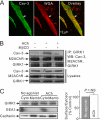Agonist-induced localization of Gq-coupled receptors and G protein-gated inwardly rectifying K+ (GIRK) channels to caveolae determines receptor specificity of phosphatidylinositol 4,5-bisphosphate signaling
- PMID: 21041306
- PMCID: PMC3009900
- DOI: 10.1074/jbc.M110.153312
Agonist-induced localization of Gq-coupled receptors and G protein-gated inwardly rectifying K+ (GIRK) channels to caveolae determines receptor specificity of phosphatidylinositol 4,5-bisphosphate signaling
Abstract
G protein-gated inwardly rectifying K(+) (GIRK) channels are parasympathetic effectors in cardiac myocytes that act as points of integration of signals from diverse pathways. Neurotransmitters and hormones acting on the Gq protein regulate GIRK channels by phosphatidylinositol 4,5-bisphosphate (PIP(2)) depletion. In previous studies, we found that endothelin-1, but not bradykinin, inhibited GIRK channels, even though both of them hydrolyze PIP(2) in cardiac myocytes, showing receptor specificity. The present study assessed whether the spatial organization of the PIP(2) signal into caveolar microdomains underlies the specificity of PIP(2)-mediated signaling. Using biochemical analysis, we examined the localization of GIRK and Gq protein-coupled receptors (GqPCRs) in mouse atrial myocytes. Agonist stimulation induced a transient co-localization of GIRK channels with endothelin receptors in the caveolae, excluding bradykinin receptors. Such redistribution was eliminated by caveolar disruption with methyl-β-cyclodextrin (MβCD). Patch clamp studies showed that the specific response of GIRK channels to GqPCR agonists was abolished by MβCD, indicating the functional significance of the caveolae-dependent spatial organization. To assess whether low PIP(2) mobility is essential for PIP(2)-mediated signaling, we blocked the cytoskeletal restriction of PIP(2) diffusion by latrunculin B. This abolished the GIRK channel regulation by GqPCRs without affecting their targeting to caveolae. These data suggest that without the hindered diffusion of PIP(2) from microdomains, PIP(2) loses its signaling efficacy. Taken together, these data suggest that specific targeting combined with restricted diffusion of PIP(2) allows the PIP(2) signal to be compartmentalized to the targets localized closely to the GqPCRs, enabling cells to discriminate between identical PIP(2) signaling that is triggered by different receptors.
Figures






Similar articles
-
Receptor-induced depletion of phosphatidylinositol 4,5-bisphosphate inhibits inwardly rectifying K+ channels in a receptor-specific manner.Proc Natl Acad Sci U S A. 2005 Mar 22;102(12):4643-8. doi: 10.1073/pnas.0408844102. Epub 2005 Mar 14. Proc Natl Acad Sci U S A. 2005. PMID: 15767570 Free PMC article.
-
Low mobility of phosphatidylinositol 4,5-bisphosphate underlies receptor specificity of Gq-mediated ion channel regulation in atrial myocytes.Proc Natl Acad Sci U S A. 2005 Oct 18;102(42):15241-6. doi: 10.1073/pnas.0408851102. Epub 2005 Oct 10. Proc Natl Acad Sci U S A. 2005. PMID: 16217031 Free PMC article.
-
Regulation of Adenosine-activated GIRK Channels by Gq-coupled Receptors in Mouse Atrial Myocytes.Korean J Physiol Pharmacol. 2010 Jun;14(3):145-50. doi: 10.4196/kjpp.2010.14.3.145. Epub 2010 Jun 30. Korean J Physiol Pharmacol. 2010. PMID: 20631886 Free PMC article.
-
Regulation of cardiac inwardly rectifying potassium channels by membrane lipid metabolism.Prog Biophys Mol Biol. 2003 Jan;81(1):67-79. doi: 10.1016/s0079-6107(02)00048-2. Prog Biophys Mol Biol. 2003. PMID: 12475570 Review.
-
Heartfelt crosstalk: desensitization of the GIRK current.Nat Cell Biol. 2000 Sep;2(9):E165-7. doi: 10.1038/35023646. Nat Cell Biol. 2000. PMID: 10980715 Review. No abstract available.
Cited by
-
Involvement of Ca2+ in Signaling Mechanisms Mediating Muscarinic Inhibition of M Currents in Sympathetic Neurons.Cell Mol Neurobiol. 2023 Jul;43(5):2257-2271. doi: 10.1007/s10571-022-01303-7. Epub 2022 Nov 11. Cell Mol Neurobiol. 2023. PMID: 36369494 Free PMC article.
-
Lipid signaling to membrane proteins: From second messengers to membrane domains and adapter-free endocytosis.J Gen Physiol. 2018 Feb 5;150(2):211-224. doi: 10.1085/jgp.201711875. Epub 2018 Jan 11. J Gen Physiol. 2018. PMID: 29326133 Free PMC article. Review.
-
Ion Channel Regulation in Caveolae and Its Pathological Implications.Cells. 2025 Apr 24;14(9):631. doi: 10.3390/cells14090631. Cells. 2025. PMID: 40358155 Free PMC article. Review.
-
Quantitative properties and receptor reserve of the DAG and PKC branch of G(q)-coupled receptor signaling.J Gen Physiol. 2013 May;141(5):537-55. doi: 10.1085/jgp.201210887. J Gen Physiol. 2013. PMID: 23630338 Free PMC article.
-
Orexin Depolarizes Central Amygdala Neurons via Orexin Receptor 1, Phospholipase C and Sodium-Calcium Exchanger and Modulates Conditioned Fear.Front Neurosci. 2018 Dec 18;12:934. doi: 10.3389/fnins.2018.00934. eCollection 2018. Front Neurosci. 2018. PMID: 30618563 Free PMC article.
References
-
- Sharifov O. F., Fedorov V. V., Beloshapko G. G., Glukhov A. V., Yushmanova A. V., Rosenshtraukh L. V. (2004) J. Am. Coll. Cardiol. 43, 483–490 - PubMed
-
- Kolettis T. M., Kyriakides Z. S., Zygalaki E., Kyrzopoulos S., Kaklamanis L., Nikolaou N., Lianidou E. S., Kremastinos D. T. (2008) J. Interv. Card. Electrophysiol. 21, 203–208 - PubMed
-
- Tsai C. T., Lai L. P., Lin J. L., Chiang F. T., Hwang J. J., Ritchie M. D., Moore J. H., Hsu K. L., Tseng C. D., Liau C. S., Tseng Y. Z. (2004) Circulation 109, 1640–1646 - PubMed
-
- Kitakaze M., Node K., Takashima S., Minamino T., Kuzuya T., Hori M. (2000) Hypertens. Res. 23, 253–259 - PubMed
Publication types
MeSH terms
Substances
LinkOut - more resources
Full Text Sources
Molecular Biology Databases

